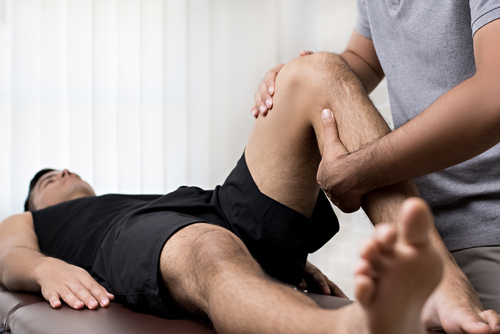
When it comes to treating hip or knee arthritis, you may have more options than you realize. The hip and knee joint move in different ways. However, the options for treating them are actually quite similar. When consulting with a Long Island orthopedist, it’s important to explore all treatment methods (without postponing) before resorting to surgical procedures.
Arthritis is defined as inflammation of the joint. Usually, it occurs as a result of wear and tear from everyday life, causing the cartilage in one’s joints to wear down. Typical symptoms include pain, swelling and stiffness, which inhibit range of motion. When the cartilage eventually wears completely away, leaving bone against bone, that can feel as bad as it sounds.
Following are the five nonsurgical treatment options for hip or knee arthritis.
1. Medication
The first option for arthritis symptoms is medication. This includes both over-the-counter (OTC) non-steroidal anti-inflammatory drugs, like Motrin, and prescription form, such as naproxen sodium. Acetaminophens (Tylenol) is solely an analgesic, which is a pain reliever, without anti-inflammatory effects.
Do not take any OTC medications for more than fourteen days without consulting with a doctor. Taking them for long periods of time can increase the chance of side effects.
Additionally, it’s important to minimize narcotics. Common narcotics to treat arthritis include hydrocodone, oxycodone and morphine. While narcotics can be very effective in reducing pain, they can often lead to addiction and cause withdrawal when trying to quit.
2. Physical Therapy
Physical therapy is one of the most crucial components in orthopedics. The goal of physical therapy for those with arthritis is to restore the use of the affected joints by improving mobility, increasing strength to support the joint, reducing joint stiffness and maintaining the ability to perform daily activities.
A physical therapist will make an individualized plan for each patient to achieve maximum physical function including balance, strength, flexibility and coordination. The therapist can teach you stretching techniques and show you how to work out stiffness without further damaging the joint.
3. Maintaining Healthy Weight
Extra weight is a problem for both hip and knee arthritis because it increases the load placed on the joint. Studies have shown that every pound on your body equates to four pounds exerted across your knees while walking, and nine pounds with stairs.
Experts recommend that patients use a body mass index calculator to learn if they are overweight or obese. Usually, they use this information to set goals to maintain a healthy weight and to reduce arthritis symptoms. In addition, in some cases, a proper diet can ease arthritis pain.
Prior to starting any major weight loss program, it’s best to meet with a doctor so they can help customize a program and safely monitor your progress.
Maintaining an optimal weight has other important benefits. Being overweight leads to significantly higher complications after hip and knee replacement. Some studies show a much higher risk of infection in overweight patients. Additionally, weight maintenance also helps the longevity of your hip and knee replacements.
Remember, every pound counts!
4. Hip & Knee Braces/Assistive Devices
A brace can provide external support for the joint, and therefore reduce load, improve stability, and relieve pain. While braces are more common for knee arthritis, there are new brace options for hip arthritis, as well.
Assistive devices are another option for hip arthritis or knee arthritis, such as a cane or walker. These can help with improving balance and providing support. A cane can support up to 25 percent of a person’s weight, while a walker can support up to 50 percent. I also utilize these assistive devices as a part of my post-surgical rehab plan after hip and knee replacements.
Prior to purchasing a brace, cane or walker, it is important to see an orthopedic specialist who can help determine if an assistive device is the best option for you.
5. Injection Options
Injections can be a great alternative to surgery. They can delay surgery for months to years, or can even substitute surgery in some patients.
The most common injection is a steroid (cortisone) injection, which decreases inflammation. It can be a great treatment option for both hip and knee arthritis.
The second option is a hyaluronic acid injection, which is a concentrated form of a protein that is naturally found in one’s joint fluid. This is used mainly for knee arthritis and is essentially a lubricating gel for the joint.
There are two other newer injection options: platelet rich plasma (PRP) injections and mesenchymal stem cells (MSC). While many studies have shown that these regenerative options are effective, unfortunately, they are not covered by most insurances.
Platelet rich plasma (PRP) is a concentrated form of a patient’s own platelets, obtained from a simple blood draw. Platelets are a potent inflammatory recruiter in the body and promote healing response to the area of injection. It can be used for arthritis, meniscal tears and tendon injuries.
Conclusion
Of course, at Central Orthopedic Group, we explore all treatment options before resigning our patients to surgery. And for hip/knee arthritis, these five treatment options have already proven effective for countless patients. We firmly believe that no one should have to endure the pain and discomfort that these conditions can induce. Therefore, we’re passionate about working with patients to eradicate their symptoms and restore their comfort and mobility as quickly and smoothly as possible.
